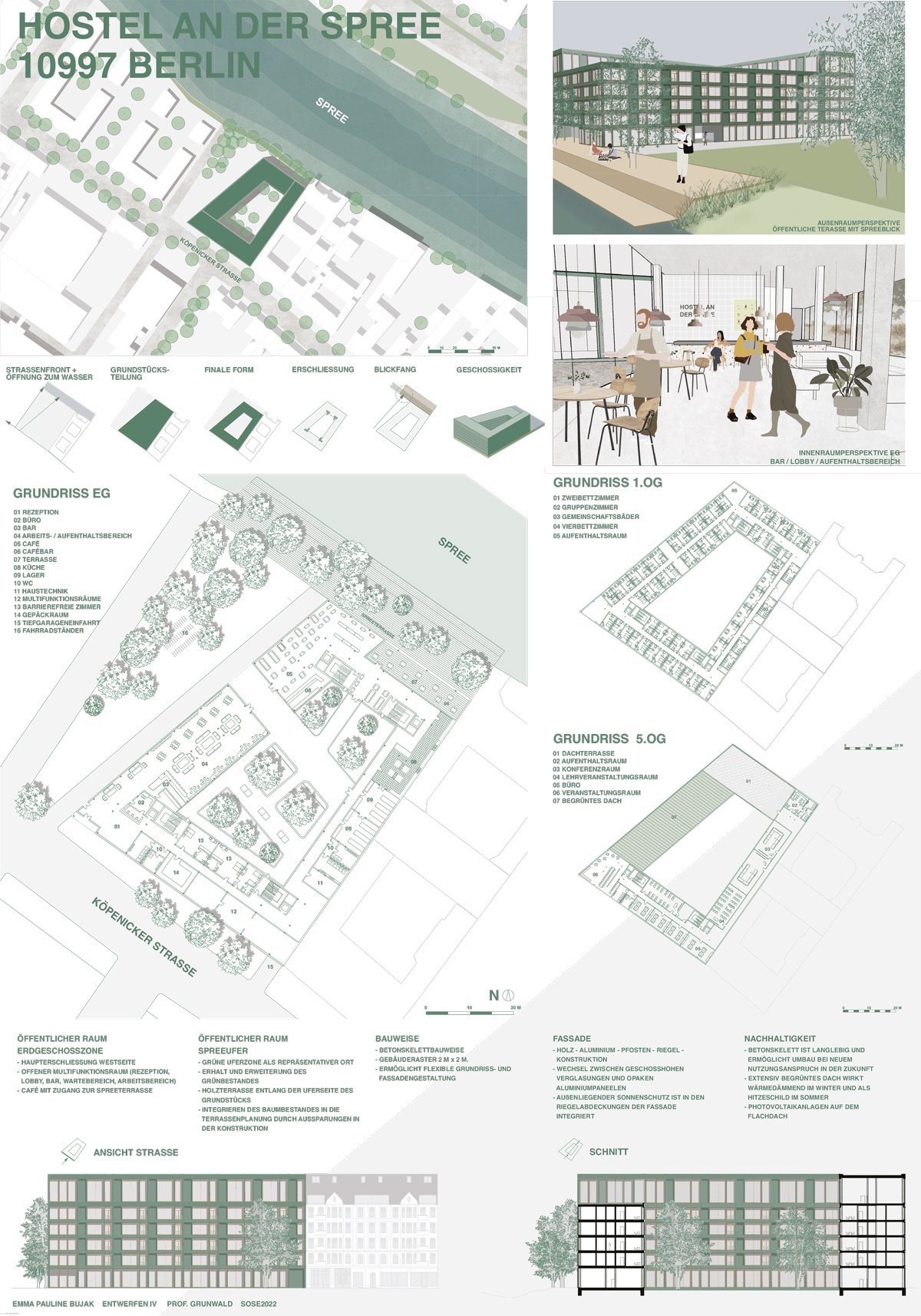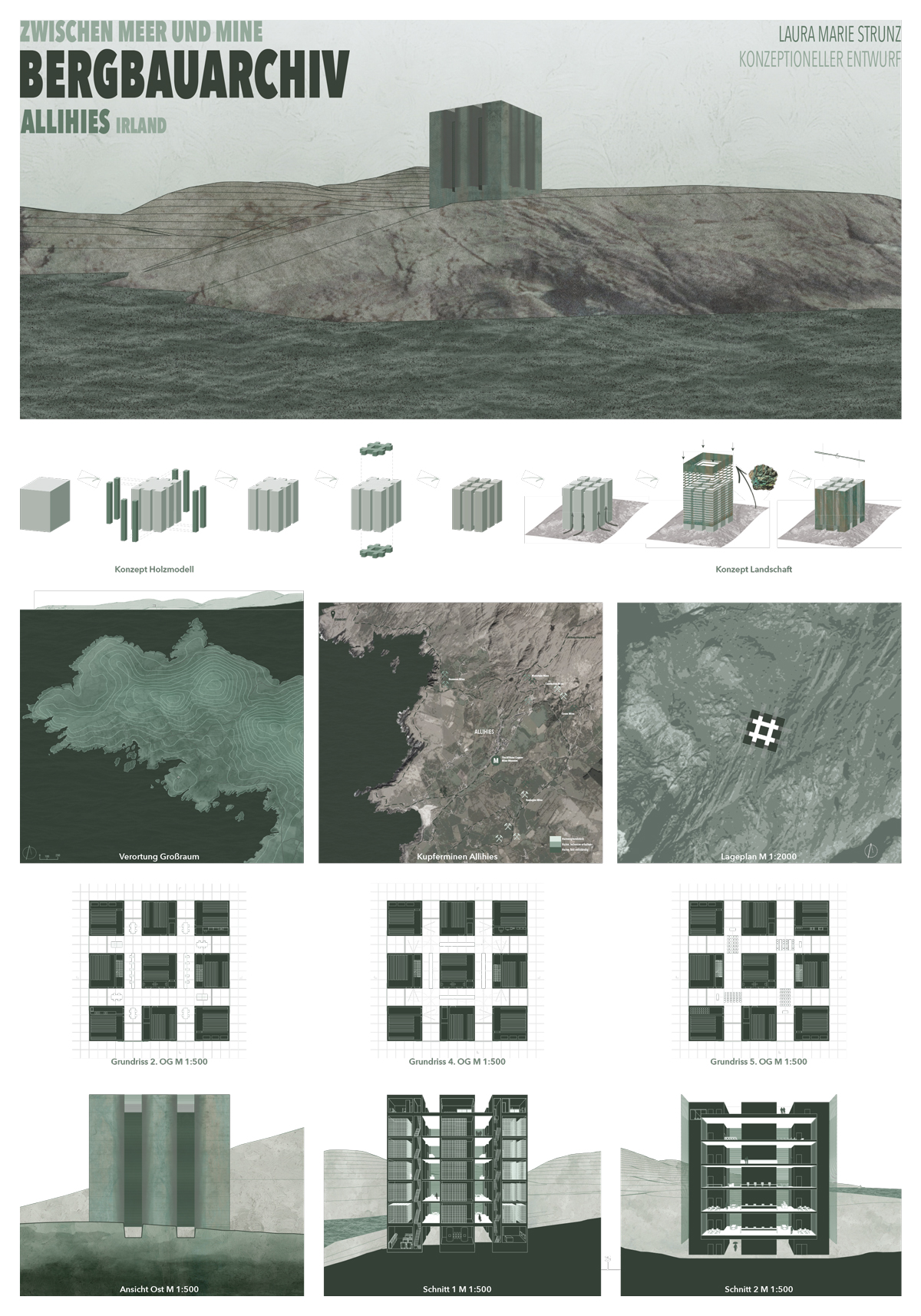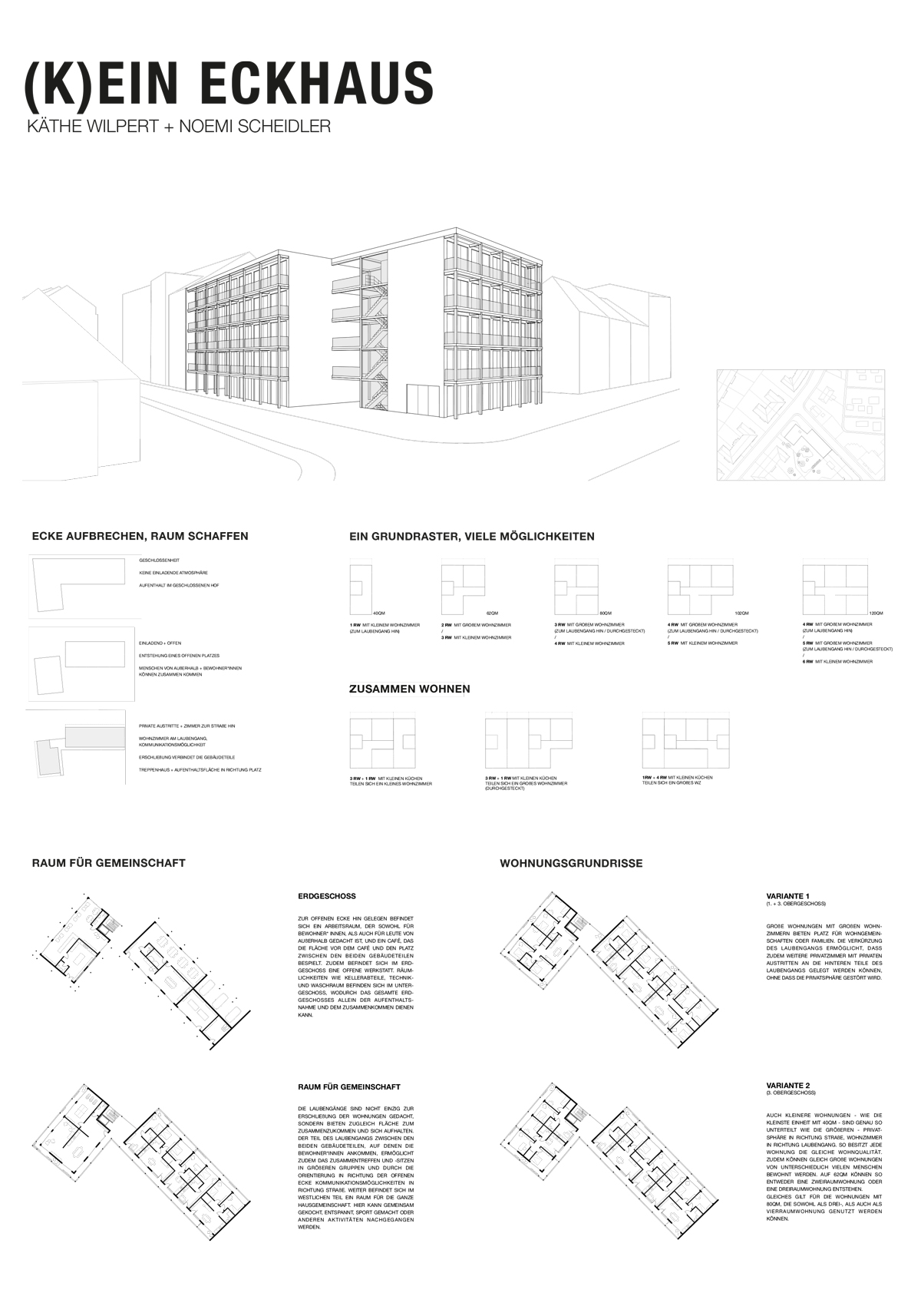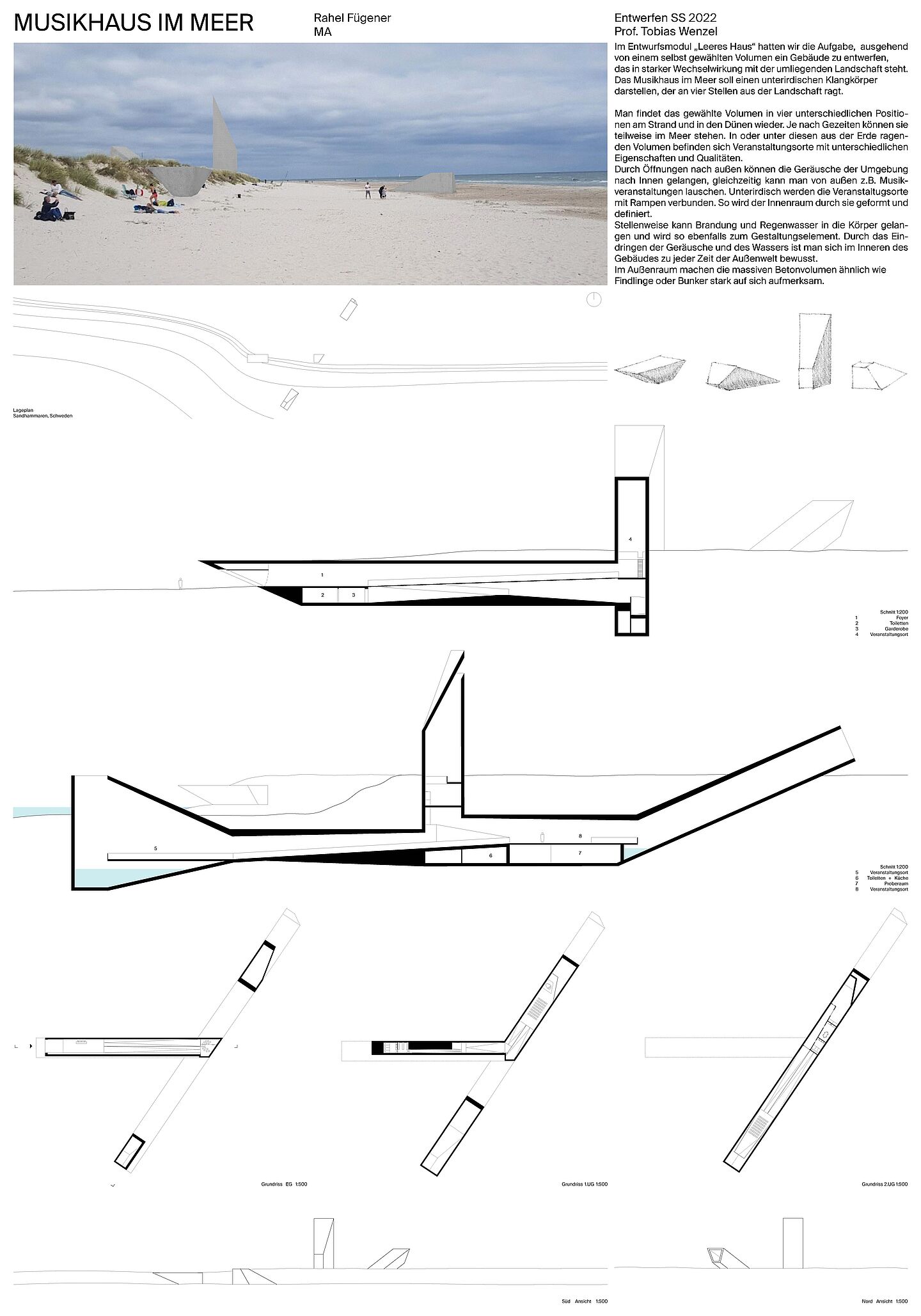Bremmer Prize 2023
Minutes of the jury meeting
The jury will meet on 11 January 2023 at 15:00.
It consists of:
- Aline Hielscher (Aline Hielscher Architecture, Leipzig)
- Prof. Christian Knoche (Prof. HTWK)
- Susanne Müller (Graduate HTWK / Hobusch Kuppard, Leipzig)
- Prof Harald Stricker (Emeritus Prof HTWK)
Prof Christian Knoche was elected as chairman.
A total of 15 works were submitted. All submitted papers were accepted for evaluation.
The list of authors of the papers with the identification numbers 01 to 15 is attached to these minutes.
Presentation by the authors
During the tour, the works were presented by the students in short presentations (5 - 8 minutes), giving the jury the opportunity to ask non-judgemental questions about the content.
The jury agreed that the architectural standard was remarkable and that the variety of the tasks was impressive. The structured presentations and the high level of attention from the students present were also favourably received.
Elimination round
The following works were eliminated after intensive discussion despite individual advocates and were therefore not shortlisted:
01, 05, 06, 08, 09, 10, 11, 13
Shortlist
The following works therefore remain on the shortlist:
02, 03, 04, 07, 12, 14, 15
After intensive, comparative discussion of the shortlisted works, the following distribution of prizes and awards was unanimously agreed:
Prize distribution
Three prizes and three commendations will be awarded:
- 1st prize (€450): Zoe Fliege, Leonard Korbus
"5 ideas towards future living"
Supervisor Prof. Christian Knoche - 2nd prize (350,-- €): Emma Bujak
"Hostel an der Spree in 10997 Berlin"
Supervisor Prof. Matthias Grunwald - 3rd prize (250,-- €): Laura Marie Strunz
"Between Sea and Mine - Mining Archive Allihies, Ireland"
Supervisor Prof. Tobias Wenzel - Recognition (150,-- €): Tanja Hartlich
"Seerosenteich - Kulturspeicher der Akademie der Künste in Berlin"
Supervisor Prof. Frank Schüler - Recognition (150,-- €): Käthe-Sophia Wilpert and Noemi Scheidler-Stecker
"Housing construction in Anger-Crottendorf"
Supervisor Prof. Christian Knoche - Recognition (150,-- €): Rahel Fügener
"Musikhaus am Meer"
Supervisor Prof. Tobias Wenzel
Shortlist
The following work remains on the shortlist without an award:
- Shortlist:
Aleksandrs Ostrovskis "Sketchy Nikolaus"
Supervisor Prof. Alexander Stahr
Jury assessment of the award-winning works:
1st prize - 5 IDEAS TOWARDS FUTURE LIVING
1st prize
Zoe Fliege, Leonard Korbus
"5 IDEAS TOWARDS FUTURE LIVING"
Supervisor Prof. Christian Knoche
The task requires an examination of the topic of residential construction on a site that is not easy due to different neighbourhoods and its non-orthogonal layout. The two architects, Zoe Fliege and Leonhard Korbus, find a good structural solution and formulate it confidently and succinctly with the unbiased freshness of the 2nd semester. There is a striking structural solution, the development respects privacy, the surrounding balconies generally create 2 exits from each flat and the communal zones on the ground floor have the right offerings and are easily accessible for everyone.
That alone is a good result, but this work goes a step further, because it formulates 5 overarching objectives as a guideline for the design, against which the two students measure and align their own design work. The fact that these objectives (sustainability, flexibility, preservation of open space, ... ) do not provide any new aspects in the current debate is more than legitimate in the second semester, but to deal with them in the seriousness and depth shown here is quite remarkable.
If, at the same time, the intellectual overload is avoided and a multifaceted, individual and contemporary design is created, then this is an outstanding achievement in the eyes of the jury, and a worthy first prize winner of the Bremmer Prize 2023. Congratulations!
2nd prize Emma Bujak "Hostel an der Spree in 10997 Berlin"
2nd prize
Emma Bujak
"Hostel an der Spree in 10997 Berlin"
Supervisor Prof. Matthias Grunwald
The construction of a new hostel on the banks of the Spree in Berlin-Kreuzberg poses a particular challenge in that the public demand for the riverbank, its general accessibility and, even more importantly, its open integration, conflict with the legitimate aspirations of an operator to optimise the use of space.
The designer Emma Bujak skilfully solves this challenge with the structural figure, the north-western wing of which is set at an angle and opens up the space from Köpenicker Strasse to the Spree in such a way that, despite the development, an enhanced urban relationship is created between the urban context and the riverbank. At the same time, the building is staggered in such a way that this relationship is also emphasised in terms of the building structure.
The result is a varied mix of public, semi-public and more private open spaces - in the urban space, on the riverbank and in the inner courtyard - that convincingly realise the potential of the situation.
The urban spatial objective described above does not lead to any compromises in terms of functionality. On the contrary: a hostel was planned that is well-developed and spatially structured, that also deals confidently with unfavourable boundary conditions such as firewall extensions or sloping corners, that offers open spaces in the right places and then also has an occupancy density that could also meet the actual requirements of planning and building - reason enough in the view of the jury to award this work 2nd prize.
3rd prize Laura Marie Strunz "Between sea and mine - Allihies Mining Archive, Ireland"
3rd prize
Laura Marie Strunz
"Between Sea and Mine - Allihies Mining Archive, Ireland"
Supervisor Prof. Tobias Wenzel
A remarkable task leads to a remarkable design. It is based on a geometrically abstract figure, in this case a regularly divided cube with a strong vertical orientation. The task is to translate this abstract figure into architecture and to find a suitable location and meaningful use for it.
Laura Marie Strunz found the site on the barren Atlantic coast in Ireland - remote, barely developed and barren, it offers the ideal situation for a strong architectural monument, monolithic, heavy and mysterious. Here, the surroundings and architecture enter into a strong relationship, so that it is difficult to imagine the building in any other place, or even to imagine this place with any other buildings.
A closer look reveals a well-structured, functional archive building with access, installations, lighting, but above all it is the spaces in between that characterise the building not only in its external appearance, but also on the inside. Here there are interesting views and vistas, into the unobstructed expanse of the surroundings, but also into the narrow and deep ravines that open up inside. A truly exciting composition based on the simplest of geometric shapes has been achieved here and it is an exciting building in the truest sense of the word that one would love to visit. This was the reason for the jury to award this design 3rd prize.
Recognition - Tanja Hartlich "Water lily pond - Kulturspeicher of the Academy of Arts in Berlin" Supervisor Prof. Frank Schüler
Recognition
Tanja Hartlich
"Seerosenteich - Kulturspeicher der Akademie der Künste in Berlin"
Supervisor Prof. Frank Schüler
The site for a cultural storage facility for the Akademie der Künste in Berlin is difficult to grasp; it is located on the edge of the Hansaviertel, separated by an elevated railway line and therefore has no clear affiliation. Tanja Hartlich's response to this situation is an elongated, orthogonal structure that sits freely in the situation without any structural references and also accommodates the mass of the spatial volume underground. Despite justified criticism of the structural complexity of 6 basement storeys, which is probably more due to the conceptual clarity, this creates a reduced visible intervention in the situation, which is sensitively enhanced in the process. This is achieved on the one hand by the public floor accommodated in a lowered floor joint, but above all by the floating roof disc that closes off the building at the top. The roof surface, which can be accessed from the inside, is designed with a shallow water basin with water lilies and thus takes on a surprisingly independent and positively irritating character. The jury congratulates on recognising this work!
Recognition - Käthe-Sophia Wilpert and Noemi Scheidler-Stecker "Housing in Anger-Crottendorf"
Recognition
Käthe-Sophia Wilpert and Noemi Scheidler-Stecker
"Housing construction in Anger-Crottendorf"
Supervisor Prof. Christian Knoche
The housing construction seminar, which is compulsory in the 2nd bachelor's semester, is intended to show conditions and typologies and explain the criteria according to which flats in multi-storey residential buildings are structured, orientated and constructed. In this seminar, Käthe Wilpert and Noemi Scheidler have very carefully addressed these issues without any fashionable posturing or superficial design effects, developing a spatially structured yet flexible floor plan system that allows for a variety of combinations. This very thorough work is characterised by the fact that it is also constructively designed and sustainability criteria are also taken into account. In addition, the authors show an astonishingly clear, true-to-scale building in the geometrically difficult existing situation, which only leaves questions unanswered with regard to its façade structure and materiality and should be further developed.
Recognition - Rahel Fügener "Musikhaus am Meer"
Recognition
Rahel Fügener
"Music House by the Sea"
Supervisor Prof Tobias Wenzel
The title is somewhat confusing, as this is not a classical concert hall built by the sea. Rather, it is a sound structure, an architectural sculpture that, based on a selected geometric figure, enters into a relationship with its surroundings in three different positions, thereby ensuring an exchange of sound. In this way, sounds from the surroundings, in particular the waves of the sea, reach the inside, but sounds from the inside, experimental music, also reach the outside and can be perceived there, for example in the dunes. The fact that the elongated hollow body, whether vertical or horizontal, guides light inwards and allows water to enter and that, like a shell, it also creates its own world of sound, further enhances and enriches the experience. The jury was impressed and honoured this work with an award.





